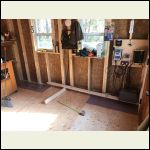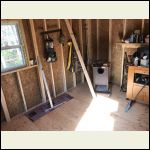|
| Author |
Message |
gwindhurst
Member
|
# Posted: 11 Oct 2022 05:18pm
Reply Quote
I’ve previously insulated my main cabin floor from the inside down. Basically, I laid 1.5†Rigid Foamular over the 3/4†Advantech subfloor, then put down 1/2†plywood over the rigid foam, and eventually my final wood flooring will go over that.Recently I’ve added an 8x10 extension onto the cabin and plan on the same technique with one modification— tarpaper. I have some leftover 30# tarpaper (not quite the red felt paper typically used under hardwoods), and was wondering if I should use it within the sandwich and at what level of the mix if I do use it?
|
|
gcrank1
Member
|
# Posted: 11 Oct 2022 06:15pm
Reply Quote
I think it depends upon if it is porous or not porous tarpaper.
|
|
gwindhurst
Member
|
# Posted: 11 Oct 2022 06:54pm - Edited by: gwindhurst
Reply Quote
Non-porous, it’s 30# black roofing tarpaper. I guess my worry is if water/condensation does happen to get in between where would I want it? I’m thinking closer to the inside surface as it would have a better chance at evaporation. Like vapor barrier/wall insulation…
|
|
gwindhurst
Member
|
# Posted: 11 Oct 2022 07:00pm
Reply Quote
So my thought is from bottom up: 3/4†Advantech, 1.5†rigid foam, #30 tarpaper, 1/2†plywood, final wood floor.
|
|
gwindhurst
Member
|
# Posted: 11 Oct 2022 07:08pm
Reply Quote
Or don’t use it at all! Just thinking out loud and looking for opinions… Thanks!
|
|
DaveBell
Moderator
|
# Posted: 11 Oct 2022 07:48pm
Reply Quote
I'm interested in this technique. I will be doing it also. Did you notice an improvement of the floor being warmer over time and warmer quicker? Others have posted that with no floor insulation, it takes forever to get the floor warm. Can you post pictures and discussion of the transitions at the doors?
Thanks,
Dave
|
|
ICC
Member
|
# Posted: 11 Oct 2022 08:47pm
Reply Quote
I believe XPS sheet foam is more water and water vapor resistant than any variety of tar paper, so adding tar paper on top should be unnecessary and a waste of material, time, and effort.
|
|
gwindhurst
Member
|
# Posted: 11 Oct 2022 08:47pm - Edited by: gwindhurst
Reply Quote
I noticed a tremendous difference in heating once I did this. Of course you have to take into account thresholds/doors/electrical boxes etc and also adding blocking between studs for a nailer depending on wall covering. As I did a shiplap I didn’t need to add blocking between studs.
0C09545DDDC447A7B.jpeg
| 
B1CA0F7277E24FEC8.jpeg
|  |  |
|
|
|
gwindhurst
Member
|
# Posted: 11 Oct 2022 08:59pm
Reply Quote
At ICC: (quote option currently not working on my phone), thanks for your input. I guess that’s been my instinct from the beginning hence I didn’t do it on the main structure. Thank you.
|
|
Brettny
Member
|
# Posted: 12 Oct 2022 09:48am
Reply Quote
Quoting: ICC believe XPS sheet foam is more water and water vapor resistant than any variety of tar paper, so adding tar paper on top should be unnecessary and a waste of material, time, and effort.
This is my thinking too. If you really want to go the extra mile you could tape the XPS.
|
|
|

